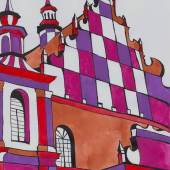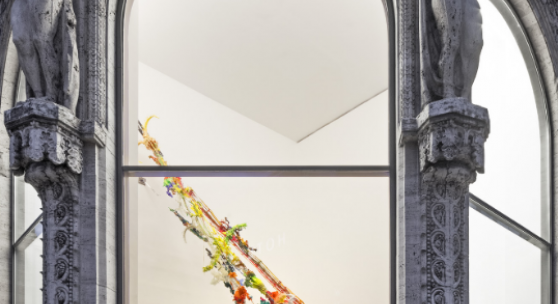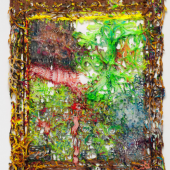FABIAN MARCACCIO法比安·玛卡乔GALLERY WEEKEND BEIJING
-
Ausstellung26.05.2023 - 04.06.2023
For our first participation at Gallery Weekend Beijing, Galerie Thomas Schulte presents the exhibition Paintants with works by Fabian Marcac-cio, featuring a suspended Environmental Painting titled 3DEP3 along-side wall-based Flex-Paintants.
As one of the pioneers of digital painting since the 1990s, Marcaccio works in what he once called ‘the expanded field of painting’ merging painting with photo-digital techniques and sculptural 3D printing in order to redefine the pictorial genre. Analytically engaging with today’s flood of media images, Marcaccio takes a critical position toward the ma-nipulative power of images and digital processing techniques. His term paintant—a composite of painting and mutant—reflects the idea of the pictorial genre in constant redevelopment and in the context of the con-stant flux of digital images as well as of the shifting values and changing world views at the beginning of the 21st century. He first demonstrated this in front of a large international audience with his work Multiple-site Paintants at the 2002 edition of documenta.
Suspended by cables, Marcaccio’s sculptural work 3DEP3 transforms the gallery space into what appears to be an apocalyptic underwater sce-nario. 3DEP3 consists of an intriguing constellation of 3D printed, paint-ed objects made from colored plastic and pigmented silicone of various dynamic and organic shapes. It resembles an open expanded pictorial nervous system, in which, on closer inspection, we can discover abstract shapes alongside identifiable objects.
For our first participation at Gallery Weekend Beijing, Galerie Thomas Schulte presents the exhibition Paintants with works by Fabian Marcac-cio, featuring a suspended Environmental Painting titled 3DEP3 along-side wall-based Flex-Paintants.As one of the pioneers of digital painting since the 1990s, Marcaccio works in what he once called ‘the expanded field of painting’ merging painting with photo-digital techniques and sculptural 3D printing in order to redefine the pictorial genre. Analytically engaging with today’s flood of media images, Marcaccio takes a critical position toward the ma-nipulative power of images and digital processing techniques. His term paintant—a composite of painting and mutant—reflects the idea of the pictorial genre in constant redevelopment and in the context of the con-stant flux of digital images as well as of the shifting values and changing world views at the beginning of the 21st century. He first demonstrated this in front of a large international audience with his work Multiple-site Paintants at the 2002 edition of documenta.Suspended by cables, Marcaccio’s sculptural work 3DEP3 transforms the gallery space into what appears to be an apocalyptic underwater sce-nario. 3DEP3 consists of an intriguing constellation of 3D printed, paint-ed objects made from colored plastic and pigmented silicone of various dynamic and organic shapes. It resembles an open expanded pictorial nervous system, in which, on closer inspection, we can discover abstract shapes alongside identifiable objects.3DEP3 is complemented by several Flex-Paintants that hover slightly from the wall’s surface. Created in the last three years during the pan-demic, these works reveal a pronounced corporeality, even when set in tension with their own dissolution. In tandem with Marcaccio’s pro-cess-oriented approach, the experience of viewing—the process of per-ception—becomes a source of action in the paintings: their appearance changes depending on our position and proximity. A ghostly image seen from a distance reveals a complex (re)organizing structure when seen up close. At times, they cannot be fully experienced unless approached from a particular angle. The Flex-Paintants are sometimes even suggestive of molecular structures. Their fibers alternately intertwining and coming undone, they are like paintings being turned inside out—we are not looking at, but into them.
Identifiable figures and forms, or else suggestions of them, sometimes come through. We might recognize faces, grids and networks, plant-like tendrils and greenery, or some combination. Fingers meld with green vines, for example, simultaneously reaching out and getting reabsorbed into the elaborate tangle of constituent color segments. In one work, the indent of a face starts to resemble a pool—becoming a source of reflection for the face of the viewer, while burrowing into the surface like a muddy footprint. What is being emphatically demonstrated is that, like the body, painting is wet, ever-changing and in flux. Taking shape as a series of frozen moments, they could liquefy in an instant, further evolving into yet unseen variants.
Bridging digital technology and organic matter in aesthetic, material, and production, the works on view are highly articulated and textured, though in varying states of abstraction and decomposition. Their abstract and fluid nature leaves them susceptible to myriad associations, bringing an increased sense of intimacy and immediacy: always emerging, they never fully crystallize.
-
23.01.2022 - 31.12.2024Berlin ist permanent im Wandel. Auch die Kunstszene der Stadt erfindet sich immer wieder neu....
-
15.09.2022 - 18.09.2022Die POSITIONS Berlin Art Fair freut sich, ihre neunte Ausgabe anzukündigen. Vom 15. – 18....
-
31.05.2024Ernst Ludwig Kirchners meisterhaftes Gemälde „Heuernte“ von 1924-26 veranschaulicht...
-
Drei Jahre später, 1877, geben die Impressionisten wieder eine Ausstellung. Es ist ihre...
-
07.03.2025 - 04.04.2025Die Galerie Thomas Schulte gratuliert dem renommierten Fotografen, Objekt- und...
-
26.05.2023 - 04.06.2023
Dienstag bis Sonntag 10–17 Uhr
Donnerstag 10–20 Uhr
Montag geschlossen



















